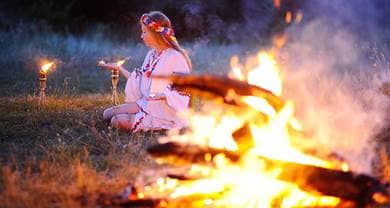- Trending:
- Pope Leo Xiv
- |
- Israel
- |
- Trump
- |
- Social Justice
- |
- Peace
- |
- Love

RELIGION LIBRARY
Paganism
Rites and Ceremonies
Most expressions of Paganism are magical - which is to say, they promote the use of individual or communal ritual practices to effect personal and environmental change, particularly changes in consciousness. Rooted in pre-modern magical practices (where rituals were seen as creating direct physical change in the environment), Pagans often have a more sophisticated understanding of magic and ritual, following Dion Fortune's definition of "magic" as "the art of changing consciousness at will." Such ceremonially enacted changes in consciousness are believed to facilitate further changes in the practitioner's life circumstances and/or relationship with the gods.
Magic can be broken down into two categories: thaumaturgy (the working of wonders) and theurgy (the divine work). Thaumaturgical magic tends to be practically oriented: magic with a specific goal in mind, whether that may be gaining a fortune, losing weight, making the crops grow, or banishing cancer. Practitioners of magic may engage in it for themselves or on behalf of another. Theurgy, by contrast, has a more spiritual and devotional focus: magic performed to foster intimacy with a god or goddess, to achieve union with the deity or deities, or to transform oneself into a more holy or godlike state.
Wiccan and other Pagan ceremonies can incorporate either or both thaumaturgical and theurgical elements. Depending on the beliefs of the individual or group performing the ceremony, a ritual can be devotionally oriented toward one or more specific deities, toward ancestral or fairy spirits, toward nature in general (sometimes personified as an Earth Goddess), or toward a generic understanding of "the god and the goddess." Likewise, depending on the beliefs and values of the ritual's enactors, the tone of the ceremony may be devotional, worshipful, or more explicitly magical. (A devotional or worshipful ritual makes few or no requests of the spirits that are invoked, whereas a magical ritual instructs or even commands the spirits to do the magician's bidding.)
Actual rituals themselves can take an almost infinite variety of forms, particularly given the strong ethos within the broad Pagan community for following one's own intuition and creating some or all the elements of personal spiritual practice. Rituals can be learned from elders and teachers, copied from a book, or created by the individual. Rituals and magical acts often make use of symbolism, which can include decorating the ritual site with colors or objects to symbolize the elements or the god(s) being invoked. Specific tools can be incorporated (for example, the Wiccan athame, or ceremonial knife, used to cut a magical boundary in the air that separates the ritual space from its mundane surroundings), and colorful clothing or robes may be worn, to help create a sense of separation from ordinary consciousness and openness to the flow of magical energy.
Some groups or traditions may have taboos associated with rituals (for example, a prohibition against wearing watches or having electronic devices like cell phones in the ritual). Candles, essential oils, incense, crystals, bells, drums or other musical instruments, and ritual foods (for offerings to the gods and/or consumption by the participants) can all be part of a ritual, depending on its purpose and function. Rituals can take place indoors, although adherents of nature religions often choose to perform ceremonies in outdoor settings - such as in a forest or around a bonfire.
What follows is a brief description of a generic Wiccan ceremony. This is only one of many possible rituals that can be performed within a Pagan tradition. At an appointed time and location (say, in a forest on the night of the full moon), the participants gather, having ritually prepared themselves with a ceremonial bath and a period of fasting. The priest and priestess (leaders of the ritual) arrive early to prepare the ground for the ceremony and to set up four shrines - one in each direction with elemental symbolism (air in the east, fire in the south, water in the west, earth in the north) - and a larger altar closer to the center of the circle, north of the fire pit, marked with symbols of the god and the goddess.
After the shrines and the altar are set up, the priest lights the bonfire while the priestess meditates. When the participants of the ritual arrive, the priest anoints each person with oil on their forehead, and smudges them (ritual purification using incense from a burning sage bundle). When everyone is gathered within the circle, the priest and priestess begin the actual ritual by sweeping the bounds of the circles, then censing it with incense, then "cutting" a boundary using the priestess's athame (ceremonial knife). Brief invocations to the spirits of the four elements are offered at each of the directional shrines.
Finally the priest and priestess face one another, standing between the bonfire and the main altar, and invoke the god and goddess to be present in one another. They kiss, and each in turn speaks prophetic words to the gathered assembly. Over the next hour, the community chants, drums, meditates, and dances to raise magical energy for particular purposes. At the direction of the priestess, this energy is used to create a "Cone of Power," which is then psychically directed to whatever goal the community has established: perhaps healing for a friend who is in the hospital, or for fertility in the local farmlands.
After the magical energy has been raised and dispersed, the priest and priestess invoke the sacred marriage between the god and the goddess by a ritual act in which he holds a chalice of ale, into which she plunges the blade of her athame. Then they bless the ale and share it with all who are present. Finally, the ritual ends by thanking and dismissing the elemental spirits and bidding farewell to the god and goddess, and ritually re-sealing the circle with the athame. Afterward, the group may linger for general feasting and merry-making.
Study Questions:
1. How is magic categorized? When is it used?
2. How are Pagan rituals structured? What do they include? What do they prohibit?
3. What is role of the priest and priestess within ritual?
4. How do Pagans utilize a circle within ritual?










